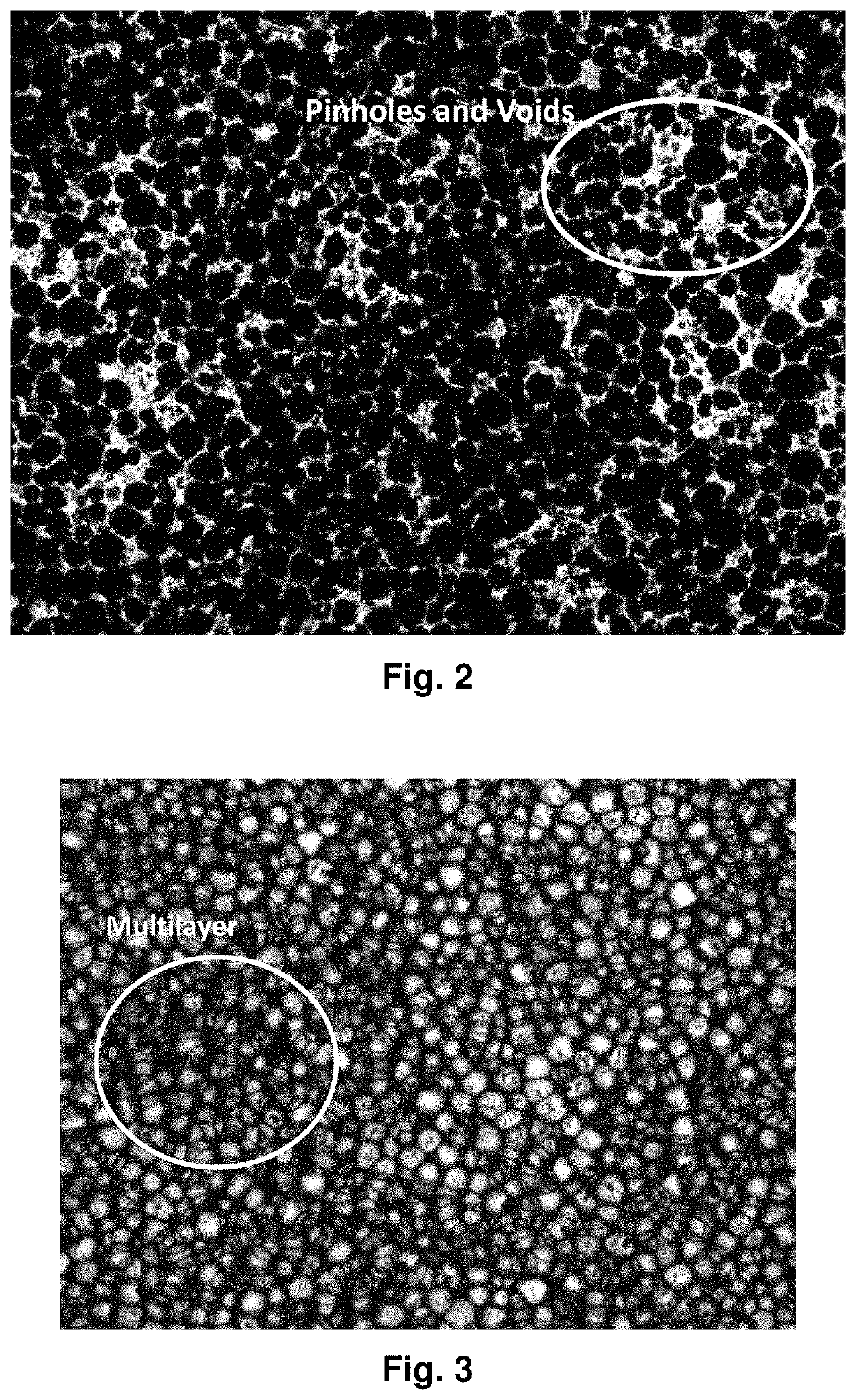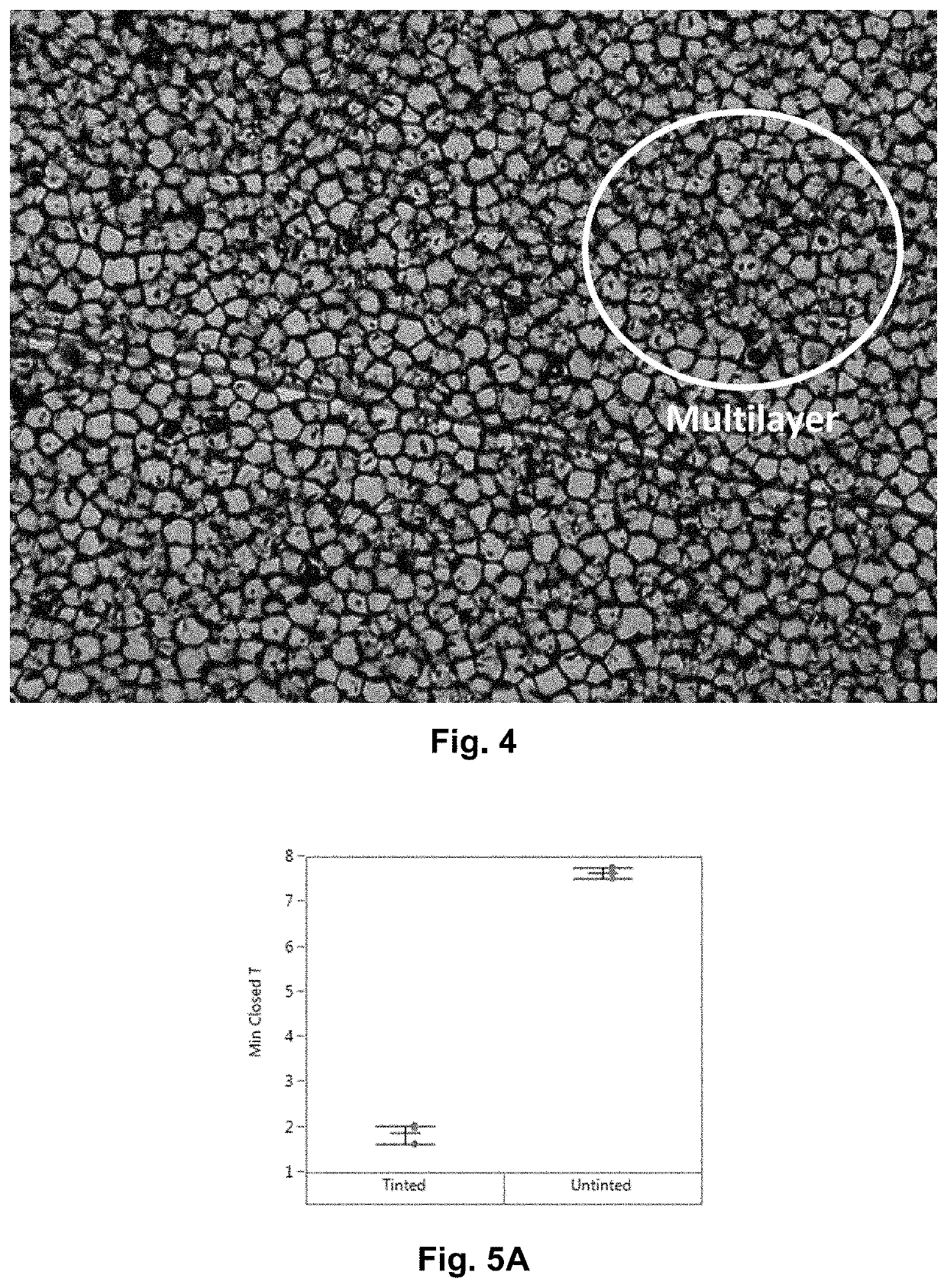Variable transmission electrophoretic devices
a transmission device and electrophoretic technology, applied in the field of variable transmission devices, can solve the problems of reducing visibility, distracting a viewer, diminishing the viewing experience in the open state, etc., and achieves the effects of reducing undesirable light scattering, reducing noise, and reducing nois
- Summary
- Abstract
- Description
- Claims
- Application Information
AI Technical Summary
Benefits of technology
Problems solved by technology
Method used
Image
Examples
example 3
[0125]The displays prepared in Example 2 above containing 2-HDA and OLOA® at a weight ratio of 0.2:1 and Span 85 and OLOA® at a weight ratio of 0.825:1 were subjected to further testing at driving voltages of 45, 60, 90 and 120 V. FIGS. 10A-10D show respectively, the maximum open transmission, minimum closed transmission, minimum open haze and contrast ratio determined in these tests.
[0126]From FIGS. 10A-10D, it will be seen that the display containing 2-HDA exhibited higher maximum open transmission, lower minimum closed transmission, lower open haze and substantially higher contrast ratio under the same conditions as the display containing Span 85. In particular, the Span 85 display failed to achieve the desirable contrast ratio of 30 under any of the tested conditions, whereas the 2-HDA display consistently achieved this contrast ratio at driving voltages of at least 60 V.
example 4
[0127]Displays were prepared as in Example 1 above containing 2-HDA and OLOA® at a weight ratio of 0.2:1 and oleic acid and OLOA® at a weight ratio of 0.4:1. These displays were subjected to testing at driving voltages of 72, 90 and 120 V. FIG. 5 shows the contrast ratios determined in these tests.
[0128]From FIG. 11, it will be seen that the display containing 2-HDA consistently exhibited substantially higher contrast ratios under the same conditions as the display containing oleic acid.
[0129]III. Variable Transmission Medium Containing Fish Gelatin:Acacia Binder
[0130]A nonaqueous internal phase was prepared by combining OLOA® 11000, 1-limonene, Cargille® 5040 immersion fluid, carbon black, polystyrene, and 2-hexyldecanoic acid. The internal phase mixture was then encapsulated by adding the mixture to an aqueous gelatin / acacia solution, emulsifying the mixture, and adding a dispersion of 10 wt. % Emperor 2000 carbon black with 5 wt. % Kolliphor P188. After mixing, heating, and pH ad...
example 1
[0155]A non-aqueous internal phase was prepared by combining OLOA® 11000, Cargille® 5040 immersion fluid, trans,trans,cis-1,5,9-cyclododecatriene (CDT), carbon black, polystyrene, and 2-hexyldecanoic acid. The resultant mixture was then encapsulated by adding the mixture to an aqueous gelatin / acacia solution, emulsifying the mixture, and adding a dispersion of 10 weight percent Emperor 2000 carbon black with 5 weight percent Kolliphor P 188. After mixing, heating, and pH adjustment, the resulting capsules were cooled and sieved to a range of 20-60 μm, with a mean size of 30-40 μm.
[0156]The resulting capsules were centrifuged and then mixed with an aqueous binder of fish gelatin (Norland HiPure Liquid Gelatin) at a ratio of 1 part by weight binder to 7 parts by weight of capsules, and an aqueous colorant dispersion comprising 10 weight percent Emperor 2000 carbon black with 5 weight percent Kolliphor P188 at a ratio of 1 part colorant dispersion to 49 parts binder. The resultant mixt...
PUM
| Property | Measurement | Unit |
|---|---|---|
| diameter | aaaaa | aaaaa |
| diameter | aaaaa | aaaaa |
| haze | aaaaa | aaaaa |
Abstract
Description
Claims
Application Information
 Login to View More
Login to View More - R&D
- Intellectual Property
- Life Sciences
- Materials
- Tech Scout
- Unparalleled Data Quality
- Higher Quality Content
- 60% Fewer Hallucinations
Browse by: Latest US Patents, China's latest patents, Technical Efficacy Thesaurus, Application Domain, Technology Topic, Popular Technical Reports.
© 2025 PatSnap. All rights reserved.Legal|Privacy policy|Modern Slavery Act Transparency Statement|Sitemap|About US| Contact US: help@patsnap.com



